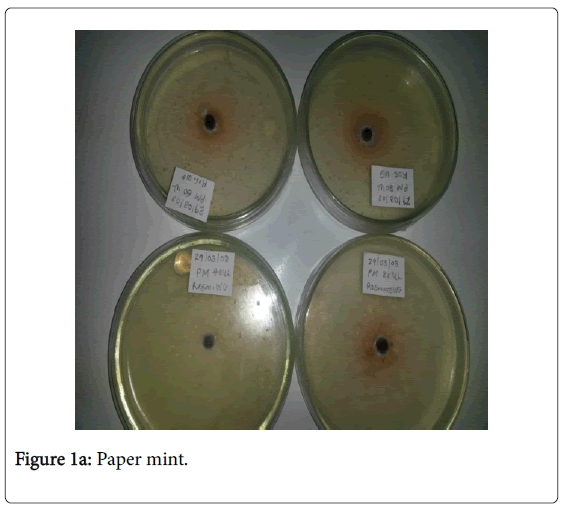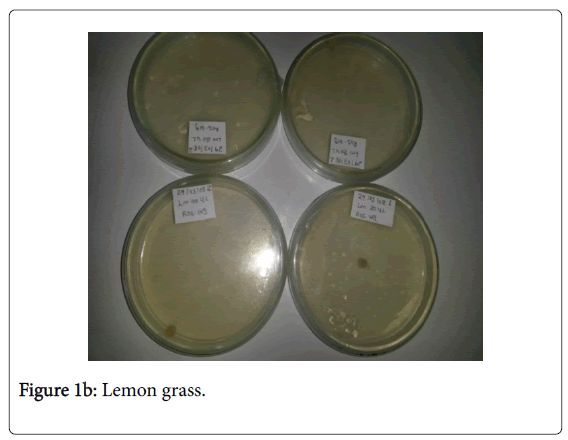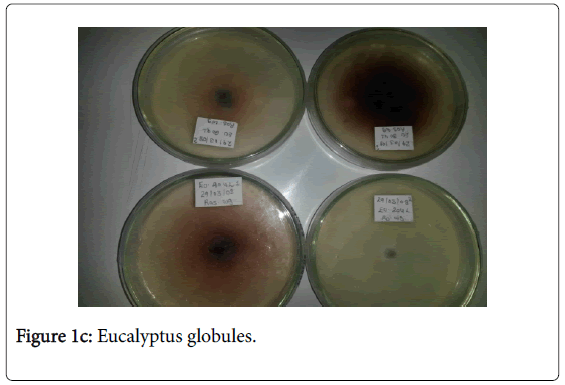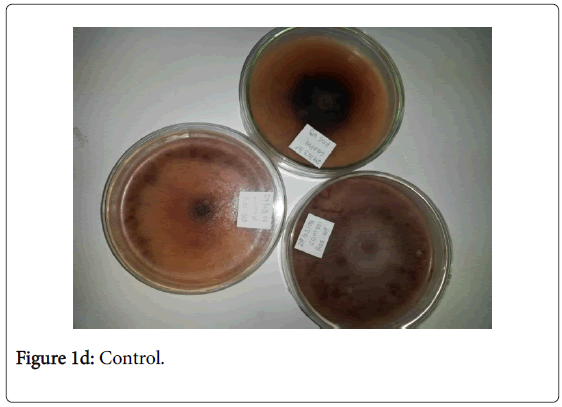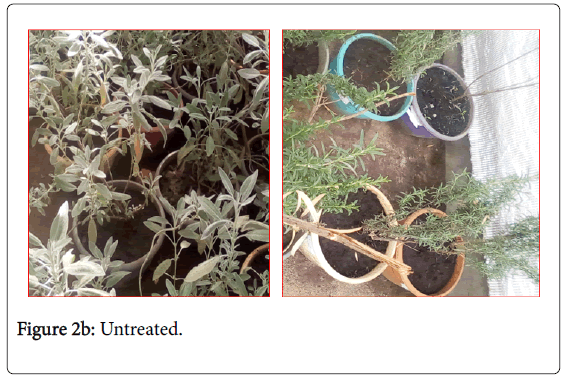Antifungal Activities of Some Essential Oils Against Fusarium oxysporum of Rosemary and Sage Plants
Received: 17-Oct-2018 / Accepted Date: 19-Jan-2019 / Published Date: 30-Jan-2019 DOI: 10.4172/2329-8863.1000419
Abstract
Rosemary (Rosmarinus officinalis L.) is a common household aromatic and medicinal plant belonging to the Labiatae family and sage (Salvia officinalis) Lamiaceae family is aromatic, rather woody perennial low shrub. This study aimed some antifungal effects of plant essential oils were investigated against fungal disease agent Fusarium oxysporum on mycilial growth inhibition in vitro and disease development reserve in vivo conditions. The tissue pieces were aseptically transferred to petridishes containing a potato dextrose agar medium supplemented with streptomycin sulfate at the rate of three to five pieces per plate. Fusarium oxysporum was grown for 7-10 days on PDA at 27°C. The concentrations were tested at 20, 40, 60 and 80 μl. The same quantity of PDA Fusarium oxysporum also established in control. F. oxysporum was cut with a sterile cork borer from the edge of actively growing cultures on PDA plates. At 20 μl, 40 μl, 60 μl and 80 μl concentration, lemon grass (100%) growth inhibition was confirmed against Fusarium wilt followed by spearmint (85.00%) and minimum inhibition recorded 25.00% at Eucalyptus. As conclusion lemon grass and spear mint essential oils demonstrated the maximum antagonistic effect against the Fusarium wilt, where as Eucalyptus inhibit the list amount of growth pathogen.
Keywords: Fusarium oxporum; Essential oil; Mycelia inhibition; In vivo; In vitro
Introduction
Rosemary (Rosmarinus officinalis L.) is a common household aromatic and medicinal plant belonging to the Labiatae family; it is endogenous to Europe, Asia and Africa, mainly around the Mediterranean Sea [1]. It is used for flavoring food, in cosmetic and in traditional medicine for choretics, hepatoprotective and antimorigenic activity; conventionally it is used for relieving visceral muscle spasms in renal colic, menstrual pain, bronchial asthma and gastrointestinal colic. It also has some therapeutic value in the treatment of disorders like, peptic ulcers, inflammatory diseases, ischemic heart disease, cataracts, and cancer [2].
Sage (Salvia officinalis) belonging to Lamiaceae family it is a common garden medicinal and aromatic herb native of the northern Mediterranean and currently cultured in different country, family reported to include more than 900 species [3]. Sage essential oil protected liver pates from oxidation processes and the herb used for relieve toothache, treatment of chronic bronchitis and thought topically for inflammation of the mucous membranes of the mouth and throat [4].
One of economically important disease in European countries on sage plants antracnosis caused by Colletotrichum dematium, ascochitosis, Ascochyta sclarea and root rot caused by Rhizoctonia solani . Similar in Italy and Spain include Phomopsis sclarea, Phodosphaera inequalis, Erysiphae polygoni and Sclerotinia sclerotiorum the major disease of sage. In California, USA major sever pathogen of sage seedlings infected by Fusarium was observed [5].
Although synthetic fungicides are effective, but continuous spaying has disturbed biological control by natural enemies and led to outbreaks in diseases, extensive development of resistance to mixture types of fungicides [6,7]. Synthetic fungicides have unfavorable environmental effects of have brought about the need for the development of new types of selective control the new alternatives broadly accepted plant product or botanicals fungicides. Due to their bioactive chemicals content essential oil bearing and botanical control of substitute currently used disease control agents [8,9].
The primary symptom of Fusarium wilt is observed by discoloration of the older leaves and change red to brown lesions on the stems. Above the ground symptoms include loss of turgour and leaf chlorosis, starting from the lower leaves, sometimes followed by leaf abscission and plant death. It may be manifested on only one side of the host plant [9]. Disease Plants are frequently under developed, growing slowly and change their color when compared to health ones.
Fusarium oxysporum caused by soil borne fungi and can survival in soil for many years as a resistant spore. It is spread by means of wind, rain, irrigation water, farm implements and crop residue. The soilborne fungus is the causal agent of vascular wilt, a disease that affects a large variety of economically important crops worldwide [10].
The produce from plant resulting compound are concentrated hydrophobic liquid including volatile aromatic compounds that have antifungal activity describe as essential oil. Plant extracted essential oils as have been used for since disease and insect pest due to for their broad spectrum antimicrobial activity and defense mechanism against plant pathogens. Several plant based extracts and plant essential oils have been reported to be effective antimicrobials against soil-borne fungi [11,12].
Chemical control have control a limited number of species, including the specific target of disease and insect pest species, integrated pest management the most excellent management alternative than chemical control. In recent years, organic pest management has great contribution for the control of fungus due to it is simply exchangeable organic material and have great role for confirm successful pest management strategy [13,14].
In the last study several reports on the antifungal activities of essential oils against plant pathogenic fungi in vitro conditions plant derivate essential oil its reach source biochemical activity alternative to currently used disease control agents. In the present study, antifungal effects of plant essential oils resulting from leaf part were investigated beside fungal disease agent Fusarium oxysporum effect of the essential oils on mycilial growth inhibition in vitro and disease development inhibition in vivo conditions.
Materials And Methods
Extraction method of essential oils
Plant extract were collected from Wondo Genet Agricultural Research Center. Above ground Air-dried plant materials (200 gms) of Cymbopogon nardus L., Mentha spicata L. and Eucalyptus citrodora Hook. The essential oils were obtained by steam distillation for 3 h using Clevenger-type apparatus (Ildam, Ankara). The extracted oils were stored at 4°C in a clean amber glass bottle for further used.
Isolation of Fusarium oxysporum
The infected tissues along with adjacent small unaffected tissues were cut into small pieces of 2-5 mm squares and were transferred by using flame-sterilized forceps to sterile petridishes containing 0.1% mercuric chloride solution. The tissue pieces were surface-sterilized in this solution for 30-60 sec and washed in sterile water two or three times. Clorox (10%) were used to sterilize the surface. The tissue pieces were aseptically transferred to petridishes containing a potato dextrose agar medium supplemented with streptomycin sulfate at the rate of three to five pieces per plate. 7-10 days on PDA at 27°C Fusarium oxysporum were grown and stock cultures obtained from single spore was preserved on PDA and sub-cultured kept at 4°C.
Efficacy of essential oils on mycelial growth in vitro conditions
This experiment carried out efficacy of essential its contact and volatile phase belongings towards mycelial growth of Fusarium oxysporum described by Sarwar et al. [15]. To see efficiency of contact effects, Eo were discrete as an emulsion in water using ethanol (0.1% v/v) and added to PDA. The concentrations were tested at 20, 40, 60 and 80 μl. The controls received the same quantity of PDA Fusarium oxysporum. The fungus was cut with a sterile cork borer from the edge of actively growing cultures on PDA plates. The culture media develop in the dark and were sealed with parafilm to prevent loss of essential oil vapors and incubated at 27°C. After ten day fungal and oil inoculation the mean radial mycelial growth of the pathogen was determined by measuring the diameter of the colony in two directions at right angles when the plate surface of the control Petri was covered by fungus. Mean inhibition percentage of mycelial growth in relation to the control treatment by using the formula, MGI (%)=((dc-dt)/dc) × 100, dc and dt represent mycelial growth diameter in control and treated Petri plates, respectively.
Efficacy of essential oil on fungal growth in vivo conditions
Cymbopogon nardus L. and Mentha spicata L. essential oil, due to its better efficacy those were selected for greenhouse trial to see the efficacy of the essential oil on Fusarium oxysporum. All experiments were arranged in a completely randomized design with five replications. (20, 40, 60, and 80 mg/l) concentrations of essential oil were prepared by dissolving the requisite amounts in distil water (0.1% v/v) solution. Three month sage and rosemary plants were sprayed with these emulsions (10 ml for each plant) uniformly using with a manually operated glass knapsack sprayer.
Statistical analysis
Analysis made using SAS software version: 9.2 and the data from two sovereign experiments were analyzed separately.
Results And Discussion
From examined essential oil it was practical observed that at 20 μl, 40 μl, 60 μl and 80 μl absorption of essential oil of lemongrass oil showed the maximum inhibition the mycelial growth, pursue by spear mint and Eucalyptus has the minimum effective.
At 20 μl, 40 μl, 60 μl and 80 μl concentration, 100% growth inhibition was recorded against Fusarium wilt by lemongrass followed by spearmint (85.00%) and minimum 25.00% for eucalyptus. All concentration of lemon grass essential oil showed entirely inhibited the growth of mycelial. Essential oils of mint were found to be antifungal 40 μl, 60 μl, 80 μl and 20 μl respectively (Figures 1a-1d).
In this study examination discovered that the three essential oils tested, had antifungal activity from minimum to maximum against F. oxysporum on sage and rosemary plants. From all tested essential oil treatments inhibited mycelial growth of F. oxysporum sage in dual culture. F. oxysporum was inhibited by Citronel oil , spearmint oil and lemon grass oil , by 100, 85 and 25% respectively. Present study it has determined that lemon grass presented highly activity to Fusarium pathogen.
The maximum inhibition zone recorded at 10 days, 20 days and 30 days, similarly from 20 μl, 40 μl, 60 μl and 80 μl minimum mycelial growth rate (25%) were found with all concentration. Similarly, Hadi and Kashefi, showed that Cinnamon extract was effective against Fusarium oxysporum. Soylu et al. [16] Reported Mentha sp. extract to cause inhibition development of Fusarium oxysporum f. sp. cumini, supports our findings. Ghorbany et al. [17] tested that the Cinnamon oil create that the oil had antifungal activity against Penicillium digitatum and Fusarium oxysporum. Cumin, Thymus and Rosemary suppressed the growth of Fusarium oxysporum f. sp. cicer mycelial it was reported by Boniface et al. [18] Plant derivative extract has antifungal activity was reported against fungi such as F. oxysporum [19] Phytophthora nicotianae [20]. It has been reported that combined treatment with rosemary oil, clove oil and thyme oil can reduce tomato Fusarium wilt much more efficiently in comparison with control effect with single treatment by clove oil, thyme oil, or rosemary oil [21].
The efficacy of plant extract against the pathogen was in the orderly of clove oil greater than lemongrass followed by mint and eucalyptus. Clove oil not only for the control of single fungi it has brode-spectrum activities to suppress several plant pathogenic fungi [22].
In our five-year examination, rosemary and sage plant highly attacked by Fusarium wilt and Phoma spp. This is probably due to major contamination in the field as continues harvesting effect of manner and also irrigation problem. From the previous study most of the aromatic and medicinal plants attacked by Fusarium and Phoma sp (Figures 2a and 2b).
This study show that root rot, vascular wilt, damping off of medicinal plant, which cause by soil borne fungi, are very significant disease in medicinal plants. Thus, it is probable medicinal plants will be planted in the vast number of fields. It is necessary that researcher consider and survey different kind of control methods or prevention of soil borne fungi disease. Moreover, control of pathogen agents of medicinal plants is different from other agricultural plants. In future, regarding to problems of chemical medicine, medicinal plants maybe will be used more than now and medicinal plant will be very important plant in future. So, it is a nice suggestion that research project concentrate on nonchemical methods or integrated pest management in order to decrease consuming of chemical and prevent adverse effects of them on human and nature [23].
Two main soil-borne fungal pathogens, Fusarium and Phoma species have been reported to cause wilting diseases in a variety of plants including Rosemary as an economic tree. Recently, these soilborne pathogens have been severely increased due to development of Rosemary plantation in the country. These soil-borne pathogens have caused root rot and wilting disease that resulted yield losses on infected plants all over the world [24] (Tables 1-3).
| S No. | Treatments | 10-days% Inhibition | 20-days% Inhibition | 30-days% Inhibition | |||||||||
|---|---|---|---|---|---|---|---|---|---|---|---|---|---|
| 20 μl | 40 μl | 60 μl | 80 μl | 20 μl | 40 μl | 60 μl | 80 μl | 20 μl | 40 μl | 60 μl | 80 μl | ||
| 1 | Spear mint | 100 | 100 | 100 | 100 | 88.89 | 90 | 86.67 | 91.11 | 77.8 | 85.6 | 87 | 81 |
| 2 | Lemon grass | 100 | 100 | 100 | 100 | 100 | 100 | 100 | 100 | 100 | 100 | 100 | 100 |
| 3 | Eucalyptus globules | 80.55 | 67.77 | 60.55 | 58.33 | 27.78 | 27.78 | 19.44 | 08.33 | 5.5 | 0 | 0 | 0 |
| 4 | Control | 0 | 0 | 0 | 0 | 0 | 0 | 0 | 0 | 0 | 0 | 0 | 0 |
Each value represents the mean of five replicates. Inhibition zone was compared using least significant difference at ≤ 5%.
Table 1: Growth inhibition of treated with different essential oils.
| Treatments (%) | PH (cm) | Brno. | FLWPP (Kg) | FSW | EOC | EOY (lit.) | DS (%) | DC (%) |
|---|---|---|---|---|---|---|---|---|
| Spear mint 20 | 78.25ab | 70.75ab | 63.76a | 22.70a | 0.310c | 19.76a | 25.00a | 0.00b |
| Spear mint 40 | 87.50a | 60.25b | 37.48cb | 17.70a | 0.170f | 6.37bc | 5.00b | 80.00a |
| Spear mint 60 | 76.00ab | 68.50ab | 39.48b | 22.87a | 0.180e | 7.10bc | 25.00a | 0.00b |
| Spear mint 80 | 76.00ab | 52.00b | 42.18b | 18.91a | 0.140h | 5.90c | 5.00b | 80.00a |
| Lemon grass 20 | 53.75b | 49.25b | 34.05cbd | 18.81a | 0.310c | 10.55b | 5.00b | 80.00a |
| Lemon grass 40 | 79.75 a | 70.50ab | 23.94cd | 22.47a | 0.290d | 6.94bc | 5.00b | 80.00a |
| Lemon grass 60 | 77.75ab | 48.25b | 30.99cbd | 18.24a | 0.160g | 4.96c | 5.00b | 80.00a |
| Lemon grass 80 | 70.00ab | 62.75ab | 21.09d | 12.79a | 0.380b | 8.01bc | 5.00b | 80.00a |
| control | 76.75ab | 93.75a | 36.48cb | 13.04a | 0.540ab | 19.70a | 25.00a | 0.00b |
| lsd | 22.227 | 31.383 | 13.898 | 15.303 | 0 | 4.3188 | 0.02 | 0.02 |
The same later within the same column are not statistically different (p<0.05). Where PH-Plant height, Brno-Branch number, FLWPP-fresh leaf weight per plant, FSWFresh stem weight, EOC-essential oil content, EOY-essential oil yield, DS-disease severity and DC disease control.
Table 2: Efficacy of essential oil on rosemary Fusarium wilts in green house condition.
| Treatments (%) | PH (cm) | Brno. | FLWPP(Kg) | FSW | EOC | EOY (lit.) | DS (%) |
|---|---|---|---|---|---|---|---|
| Spear mint 20 | 87.75bac | 43.00e | 53.34ba | 37.02ab | 0.360e | 13.32b | 5.00b |
| Spear mint 40 | 96.00ba | 45.25e | 55.25ba | 35.29bac | 0.400c | 14.11b | 5.00b |
| Spear mint 60 | 73.75c | 47.50de | 42.23b | 32.44bc | 0.350f | 11.35cb | 5.00b |
| Spear mint 80 | 88.00bac | 40.75e | 40.65b | 31.29bc | 0.430b | 13.45b | 5.00b |
| Lemon grass 20 | 87.50bac | 67.75c | 41.72b | 33.09bc | 0.380d | 12.57cb | 5.00b |
| Lemon grass 40 | 85.75bac | 66.00dc | 43.09b | 26.56c | 0.350f | 9.29c | 5.00b |
| Lemon grass 60 | 96.25ba | 89.25b | 58.60ba | 34.70bc | 0.380d | 13.18b | 5.00b |
| Lemon grass 80 | 102.00a | 112.00a | 71.16a | 43.74a | 0.470a | 20.56a | 3.00c |
| control | 77.25bc | 54.50dce | 41.73b | 31.83bc | 0.470a | 14.96b | 20.00a |
| lsd | 19.335 | 18.943 | 20.803 | 8.765 | 0 | 3.707 | 1.123 |
The same later within the same column are not statistically different (p<0.05). Where PH–Plant height, Brno- Branch number, FLWPP–fresh leaf weight per plant, FSW- Fresh stem weight, EOC-essential oil content, EOY-essential oil yield, DS-disease severity and DC disease control.
Table 3: Efficacy of essential oil on on sage Fusarium wilts in green house condition.
Conclusion
In conclusion lemon grass and spear mint essential oils showed the maximum anti-fungal activity against the Fusarium wilt on both sage and rosemary plants, whereas Eucalyptus inhibit the list amount of growth pathogen. If these antifungal activities also effective in field conditions, they can be used as option for the management of Fusarium wilt and used as alternative to chemical control which is environmentally safe. Therefore, developing commercial products containing several plant essential oils might be promising as ecofriendly strategy to control sage and rosemary Fusarium wilt.
Acknowledgements
The authors would like to express their gratitude to Institute of agricultural research science, and plant pathology program for financial support awarded to the scientific project activity.
References
- Pintore G, Usai M, Bradesi P, Juliano C, Boatto G, et al. (2002) Chemical composition and antimicrobial activity of Rosmarinus officinalis L. oils from Sardinia and Corsica. Flavour Fragr J 17: 15-19.
- Valenzuela A, Sanhueza J, Alonso P, Corbari A, Nieto S (2004) Inhibitory action of conventional food-grade natural antioxidants and of natural antioxidants of new development on the thermal-induced oxidation of cholesterol. IJFS 55: 155-162.
- Ilkiu-Vidal LH, Souza JRP, Viani RAG (2010) Action of hydrogenation potentials on the growth and productivity of sage (Salvia officinalis L.). Brazilian Journal of Medicinal Plants.
- Egel DS, Martyn RD (2007) Fusarium wilt of watermelon and other cucurbits. The Plant Health Instructor 2: 1.
- Subbiah VP, Riddick M, Peele D, Reynolds RJ, Cubeta MA (1996) First report of Fusarium oxysporum on clary sage in North America. Plant Disease 2: 1.
- Staub T (1991) Fungicide resistance: Practical experience with anti-resistance strategies and the role of integrated use. Annual Review of Phytopathology 29: 421-442.
- Elad Y, Yunis H, Katan T (1992) Multiple resistance to benzimidazoles dicarboximides and Fusarium oxysporum the causal of wilt disease of pepper (Capsicum annum L.). Int J Agric 2: 1.
- Isman MB (2000) Plant essential oils for pest and disease management. Crop Protection 19: 603-608.
- Burt S (2004) Essential oils: Their antibacterial properties and potential applications in foods-a review. Int J Food Microbiol 94: 223-253.
- Schwartz HF, Steadman JR, Hall R, Forster RL (2005) Compendium of bean diseases. American Phytopathological Society (APS Press).
- Ortoneda M, Guarro J, Madrid MP, Caracuel Z, Roncero MIG, et al. (2004) Fusarium oxysporum as a multihost model for the genetic dissection of fungal virulence in plants and mammals. Infection and Immunity 72: 1760-1766.
- Arıcı ȘE, Özgönen H, Șanlı A, Polat M, Yasan G (2011) Antimicrobial activity of essential oils against agricultural plant pathogenic fungi and bacteria. In 4th International Conference on Alternative Methods in Crop Protection. Evolution of the European and French regulatory frameworks. New Innovative Ways and Strategies, New Century, Lille, France pp: 249-253.
- Hashem M, Moharam AM, Zaied AA, Saleh FEM (2010) Efficacy of essential oils in the control of cumin root rot disease caused by Fusarium spp. Crop Protection 29: 1111-1117.
- Ahmad N, Sarwar M, Khan GZ, Tofique M, Salam A (2011) Efficacy of some plant products and synthetic chemicals to manage the outbreak of mealy bug (Maconellicoccus hirsutus) in Cotton. JABS 3: 16-21.
- Sarwar M, Ahmad N, Tofique M (2012) Potential of plant materials for the management of cowpea bruchid Callosobruchus analis (Coleoptera: Bruchidae) in gram Cicer arietinum during storage. Nucleus (Islamabad) 49: 61-64.
- Soylu EM, Soylu S, Kurt S (2006) Antimicrobial activities of the essential oils of various plants against tomato late blight disease agent Phytophthora infestans. Mycopathologia 161: 119-128.
- Ghorbany M, Jafarpour B, Rastegar MF (2010) Application of some plant products to control of Fusarium Oxysporum F. Sp Cumini Causing Cumin Wilt. Journal of Plant Protection 24: 1.
- Boniface Y, Philippe S, De-Lima HR, Pierre NJ, Alain AG, et al. (2012) Chemical composition and antimicrobial activities of Cinnamomum zeylanicum Blume dry leaves essential oil against food-borne pathogens and adulterated microorganisms. Research Journal of Biological Science 1: 18-25.
- Pawar VC, Thaker VS (2007) Evaluation of the anti-Fusarium oxysporum f. sp cicer and anti-Alternaria porri effects of some essential oils. World Journal of Microbiology and Biotechnology 23: 1099-1106.
- Bruton BD, Garcia-Jimenez J, Armengol J, Popham TW (2000) Assessment of virulence of Acremonium cucurbitacearum and Monosporascus cannonballus on Cucumis melo. Plant Disease 84: 907-913.
- Bowers JH, Locke JC (2004) Effect of formulated plant extracts and oils on population density of Phytophthora nicotianae in soil and control of Phytophthora blight in the greenhouse. Plant Disease 88: 11-16.
- La-Torre A, Caradonia F, Matere A, Battaglia V (2016) Using plant essential oils to control Fusarium wilt in tomato plants. Eur J Plant Patho 144: 487-496.
- Ragab MM, Ashour AMA, Abdel-Kader MM, El-Mohamady R, Abdel-Aziz A (2012) In vitro evaluation of some fungicides alternatives against Fusarium oxysporum the causal of wilt disease of pepper (Capsicum annum L.). International Journal of Agriculture and Forestry 2: 70-77.
- Purohit SS, Vyas SP (2004) Medicinal plant cultivation: A scientific approach: Including Processing and Financial Guidelines. Agrobios 2: 1.
Citation: Mekonnen M, Wariyo A, Hilu G (2019) Antifungal Activities of Some Essential Oils Against Fusarium oxysporum of Rosemary and Sage Plants. Adv Crop Sci Tech 7: 419. DOI: 10.4172/2329-8863.1000419
Copyright: © 2019 Mekonnen M, et al. This is an open-access article distributed under the terms of the Creative Commons Attribution License, which permits unrestricted use, distribution, and reproduction in any medium, provided the original author and source are credited.
Select your language of interest to view the total content in your interested language
Share This Article
Recommended Journals
Open Access Journals
Article Tools
Article Usage
- Total views: 7669
- [From(publication date): 0-2019 - Dec 01, 2025]
- Breakdown by view type
- HTML page views: 6624
- PDF downloads: 1045

